| Fungi Temporal range: Early Devonian–Recent (but see text) | |
|---|---|
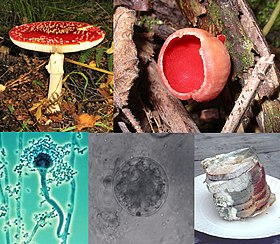 | |
| Clockwise from top left: Amanita muscaria, a basidiomycete; Sarcoscypha coccinea, an ascomycete; bread covered in mold; a chytrid; a Penicillium conidiophore. | |
| Scientific classification | |
| Domain: | Eukaryota |
| (unranked): | Opisthokonta |
| Kingdom: | Fungi (L., 1753) R.T. Moore, 1980[1] |
| Subkingdoms/Phyla/Subphyla[2] | |
Dikarya (inc. Deuteromycota) Subphyla Incertae sedis | |
Abundant worldwide, most fungi are inconspicuous because of the small size of their structures, and their cryptic lifestyles in soil, on dead matter, and as symbionts of plants, animals, or other fungi. They may become noticeable when fruiting, either as mushrooms or molds. Fungi perform an essential role in the decomposition of organic matter and have fundamental roles in nutrient cycling and exchange. They have long been used as a direct source of food, such as mushrooms and truffles, as a leavening agent for bread, and in fermentation of various food products, such as wine, beer, and soy sauce. Since the 1940s, fungi have been used for the production of antibiotics, and, more recently, various enzymes produced by fungi are used industrially and in detergents. Fungi are also used as biological pesticides to control weeds, plant diseases and insect pests. Many species produce bioactive compounds called mycotoxins, such as alkaloids and polyketides, that are toxic to animals including humans. The fruiting structures of a few species contain psychotropic compounds and are consumed recreationally or in traditional spiritual ceremonies. Fungi can break down manufactured materials and buildings, and become significant pathogens of humans and other animals. Losses of crops due to fungal diseases (e.g. rice blast disease) or food spoilage can have a large impact on human food supplies and local economies.
The fungus kingdom encompasses an enormous diversity of taxa with varied ecologies, life cycle strategies, and morphologies ranging from single-celled aquatic chytrids to large mushrooms. However, little is known of the true biodiversity of Kingdom Fungi, which has been estimated at around 1.5 million species, with about 5% of these having been formally classified. Ever since the pioneering 18th and 19th century taxonomical works of Carl Linnaeus, Christian Hendrik Persoon, and Elias Magnus Fries, fungi have been classified according to their morphology (e.g., characteristics such as spore color or microscopic features) or physiology. Advances in molecular genetics have opened the way for DNA analysis to be incorporated into taxonomy, which has sometimes challenged the historical groupings based on morphology and other traits. Phylogenetic studies published in the last decade have helped reshape the classification of Kingdom Fungi, which is divided into one subkingdom, seven phyla, and ten subphyla.
Contents |
Etymology
The English word fungus is directly adopted from the Latin fungus (mushroom), used in the writings of Horace and Pliny.[5] This in turn is derived from the Greek word sphongos/σφογγος ("sponge"), which refers to the macroscopic structures and morphology of mushrooms and molds; the root is also used in other languages, such as the German Schwamm ("sponge"), Schimmel ("mold"), and the French champignon and the Spanish champiñon (which both mean "mushroom").[6] The use of the word mycology, which is derived from the Greek mykes/μύκης (mushroom) and logos/λόγος (discourse),[7] to denote the scientific study of fungi is thought to have originated in 1836 with English naturalist Miles Joseph Berkeley's publication The English Flora of Sir James Edward Smith, Vol. 5.[6]Characteristics
Before the introduction of molecular methods for phylogenetic analysis, taxonomists considered fungi to be members of the Plant Kingdom because of similarities in lifestyle: both fungi and plants are mainly immobile, and have similarities in general morphology and growth habitat. Like plants, fungi often grow in soil, and in the case of mushrooms form conspicuous fruiting bodies, which sometimes bear resemblance to plants such as mosses. The fungi are now considered a separate kingdom, distinct from both plants and animals, from which they appear to have diverged around one billion years ago.[8][9] Some morphological, biochemical, and genetic features are shared with other organisms, while others are unique to the fungi, clearly separating them from the other kingdoms:Shared features:
- With other eukaryotes: As other eukaryotes, fungal cells contain membrane-bound nuclei with chromosomes that contain DNA with noncoding regions called introns and coding regions called exons. In addition, fungi possess membrane-bound cytoplasmic organelles such as mitochondria, sterol-containing membranes, and ribosomes of the 80S type.[10] They have a characteristic range of soluble carbohydrates and storage compounds, including sugar alcohols (e.g., mannitol), disaccharides, (e.g., trehalose), and polysaccharides (e.g., glycogen, which is also found in animals[11]).
- With animals: Fungi lack chloroplasts and are heterotrophic organisms, requiring preformed organic compounds as energy sources.[12]
- With plants: Fungi possess a cell wall[13] and vacuoles.[14] They reproduce by both sexual and asexual means, and like basal plant groups (such as ferns and mosses) produce spores. Similar to mosses and algae, fungi typically have haploid nuclei.[15]
- With euglenoids and bacteria: Higher fungi, euglenoids, and some bacteria produce the amino acid L-lysine in specific biosynthesis steps, called the α-aminoadipate pathway.[16][17]
- The cells of most fungi grow as tubular, elongated, and thread-like (filamentous) structures and are called hyphae, which may contain multiple nuclei and extend at their tips. Each tip contains a set of aggregated vesicles—cellular structures consisting of proteins, lipids, and other organic molecules—called Spitzenkörper.[18] Both fungi and oomycetes grow as filamentous hyphal cells.[19] In contrast, similar-looking organisms, such as filamentous green algae, grow by repeated cell division within a chain of cells.[11]
- In common with some plant and animal species, more than 60 fungal species display the phenomenon of bioluminescence.[20]
- Some species grow as single-celled yeasts that reproduce by budding or binary fission. Dimorphic fungi can switch between a yeast phase and a hyphal phase in response to environmental conditions.[21]
- The fungal cell wall is composed of glucans and chitin; while the former compounds are also found in plants and the latter in the exoskeleton of arthropods,[22][23] fungi are the only organisms that combine these two structural molecules in their cell wall. In contrast to plants and the oomycetes, fungal cell walls do not contain cellulose.[24]
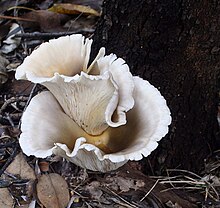
Omphalotus nidiformis, a bioluminescent mushroom
Diversity
Fungi have a worldwide distribution, and grow in a wide range of habitats, including extreme environments such as deserts or areas with high salt concentrations[29] or ionizing radiation,[30] as well as in deep sea sediments.[31] Some can survive the intense UV and cosmic radiation encountered during space travel.[32] Most grow in terrestrial environments, though several species live partly or solely in aquatic habitats, such as the chytrid fungus Batrachochytrium dendrobatidis, a parasite that has been responsible for a worldwide decline in amphibian populations. This organism spends part of its life cycle as a motile zoospore, enabling it to propel itself through water and enter its amphibian host.[33] Other examples of aquatic fungi include those living in hydrothermal areas of the ocean.[34]Around 100,000 species of fungi have been formally described by taxonomists,[35] but the global biodiversity of the fungus kingdom is not fully understood.[36] On the basis of observations of the ratio of the number of fungal species to the number of plant species in selected environments, the fungal kingdom has been estimated to contain about 1.5 million species.[37] In mycology, species have historically been distinguished by a variety of methods and concepts. Classification based on morphological characteristics, such as the size and shape of spores or fruiting structures, has traditionally dominated fungal taxonomy.[38] Species may also be distinguished by their biochemical and physiological characteristics, such as their ability to metabolize certain biochemicals, or their reaction to chemical tests. The biological species concept discriminates species based on their ability to mate. The application of molecular tools, such as DNA sequencing and phylogenetic analysis, to study diversity has greatly enhanced the resolution and added robustness to estimates of genetic diversity within various taxonomic groups.[39]
Morphology
Microscopic structures
Most fungi grow as hyphae, which are cylindrical, thread-like structures 2–10 µm in diameter and up to several centimeters in length. Hyphae grow at their tips (apices); new hyphae are typically formed by emergence of new tips along existing hyphae by a process called branching, or occasionally growing hyphal tips bifurcate (fork) giving rise to two parallel-growing hyphae.[40] The combination of apical growth and branching/forking leads to the development of a mycelium, an interconnected network of hyphae.[21] Hyphae can be either septate or coenocytic: septate hyphae are divided into compartments separated by cross walls (internal cell walls, called septa, that are formed at right angles to the cell wall giving the hypha its shape), with each compartment containing one or more nuclei; coenocytic hyphae are not compartmentalized.[41] Septa have pores that allow cytoplasm, organelles, and sometimes nuclei to pass through; an example is the dolipore septum in the fungi of the phylum Basidiomycota.[42] Coenocytic hyphae are essentially multinucleate supercells.[43]Many species have developed specialized hyphal structures for nutrient uptake from living hosts; examples include haustoria in plant-parasitic species of most fungal phyla, and arbuscules of several mycorrhizal fungi, which penetrate into the host cells to consume nutrients.[44]
Although fungi are opisthokonts—a grouping of evolutionarily related organisms broadly characterized by a single posterior flagellum—all phyla except for the chytrids have lost their posterior flagella.[45] Fungi are unusual among the eukaryotes in having a cell wall that, in addition to glucans (e.g., β-1,3-glucan) and other typical components, also contains the biopolymer chitin.[46]
Macroscopic structures
Fungal mycelia can become visible to the naked eye, for example, on various surfaces and substrates, such as damp walls and on spoiled food, where they are commonly called molds. Mycelia grown on solid agar media in laboratory petri dishes are usually referred to as colonies. These colonies can exhibit growth shapes and colors (due to spores or pigmentation) that can be used as diagnostic features in the identification of species or groups.[47] Some individual fungal colonies can reach extraordinary dimensions and ages as in the case of a clonal colony of Armillaria solidipes, which extends over an area of more than 900 ha (3.5 square miles), with an estimated age of nearly 9,000 years.[48]The apothecium—a specialized structure important in sexual reproduction in the ascomycetes—is a cup-shaped fruiting body that holds the hymenium, a layer of tissue containing the spore-bearing cells.[49] The fruiting bodies of the basidiomycetes (basidiocarps) and some ascomycetes can sometimes grow very large, and many are well-known as mushrooms.
Growth and physiology
The growth of fungi as hyphae on or in solid substrates or as single cells in aquatic environments is adapted for the efficient extraction of nutrients, because these growth forms have high surface area to volume ratios.[50] Hyphae are specifically adapted for growth on solid surfaces, and to invade substrates and tissues.[51] They can exert large penetrative mechanical forces; for example, the plant pathogen Magnaporthe grisea forms a structure called an appressorium which evolved to puncture plant tissues.[52] The pressure generated by the appressorium, directed against the plant epidermis, can exceed 8 megapascals (1,200 psi).[52] The filamentous fungus Paecilomyces lilacinus uses a similar structure to penetrate the eggs of nematodes.[53]Traditionally, the fungi are considered heterotrophs, organisms that rely solely on carbon fixed by other organisms for metabolism. Fungi have evolved a high degree of metabolic versatility that allows them to use a diverse range of organic substrates for growth, including simple compounds such as nitrate, ammonia, acetate, or ethanol.[63][64] For some species it has been shown that the pigment melanin may play a role in extracting energy from ionizing radiation, such as gamma radiation; however, this form of "radiotrophic" growth has only been described for a few species, the effects on growth rates are small, and the underlying biophysical and biochemical processes are not known.[30] The authors speculate that this process might bear similarity to CO2 fixation via visible light, but instead utilizing ionizing radiation as a source of energy.[65]
Reproduction
Fungal reproduction is complex, reflecting the differences in lifestyles and genetic makeup within this kingdom of organisms.[66] It is estimated that a third of all fungi reproduce by different modes of propagation; for example, reproduction may occur in two well-differentiated stages within the life cycle of a species, the teleomorph and the anamorph.[67] Environmental conditions trigger genetically determined developmental states that lead to the creation of specialized structures for sexual or asexual reproduction. These structures aid reproduction by efficiently dispersing spores or spore-containing propagules.Asexual reproduction
Asexual reproduction via vegetative spores (conidia) or through mycelial fragmentation is common; it maintains clonal populations adapted to a specific niche, and allows more rapid dispersal than sexual reproduction.[68] The "Fungi imperfecti" (fungi lacking the perfect or sexual stage) or Deuteromycota comprise all the species which lack an observable sexual cycle.[69]Sexual reproduction
Sexual reproduction with meiosis exists in all fungal phyla (with the exception of the Glomeromycota).[70] It differs in many aspects from sexual reproduction in animals or plants. Differences also exist between fungal groups and can be used to discriminate species by morphological differences in sexual structures and reproductive strategies.[71][72] Mating experiments between fungal isolates may identify species on the basis of biological species concepts.[72] The major fungal groupings have initially been delineated based on the morphology of their sexual structures and spores; for example, the spore-containing structures, asci and basidia, can be used in the identification of ascomycetes and basidiomycetes, respectively. Some species may allow mating only between individuals of opposite mating type, while others can mate and sexually reproduce with any other individual or itself. Species of the former mating system are called heterothallic, and of the latter homothallic.[73]Most fungi have both an haploid and diploid stage in their life cycles. In sexually reproducing fungi, compatible individuals may combine by fusing their hyphae together into an interconnected network; this process, anastomosis, is required for the initiation of the sexual cycle. Ascomycetes and basidiomycetes go through a dikaryotic stage, in which the nuclei inherited from the two parents do not combine immediately after cell fusion, but remain separate in the hyphal cells (see heterokaryosis).[74]
In ascomycetes, dikaryotic hyphae of the hymenium (the spore-bearing tissue layer) form a characteristic hook at the hyphal septum. During cell division, formation of the hook ensures proper distribution of the newly divided nuclei into the apical and basal hyphal compartments. An ascus (plural asci) is then formed, in which karyogamy (nuclear fusion) occurs. Asci are embedded in an ascocarp, or fruiting body. Karyogamy in the asci is followed immediately by meiosis and the production of ascospores. After dispersal, the ascospores may germinate and form a new haploid mycelium.[75]
Sexual reproduction in basidiomycetes is similar to that of the ascomycetes. Compatible haploid hyphae fuse to produce a dikaryotic mycelium. However, the dikaryotic phase is more extensive in the basidiomycetes, often also present in the vegetatively growing mycelium. A specialized anatomical structure, called a clamp connection, is formed at each hyphal septum. As with the structurally similar hook in the ascomycetes, the clamp connection in the basidiomycetes is required for controlled transfer of nuclei during cell division, to maintain the dikaryotic stage with two genetically different nuclei in each hyphal compartment.[76] A basidiocarp is formed in which club-like structures known as basidia generate haploid basidiospores after karyogamy and meiosis.[77] The most commonly known basidiocarps are mushrooms, but they may also take other forms (see Morphology section).
In glomeromycetes (formerly zygomycetes), haploid hyphae of two individuals fuse, forming a gametangium, a specialized cell structure that becomes a fertile gamete-producing cell. The gametangium develops into a zygospore, a thick-walled spore formed by the union of gametes. When the zygospore germinates, it undergoes meiosis, generating new haploid hyphae, which may then form asexual sporangiospores. These sporangiospores allow the fungus to rapidly disperse and germinate into new genetically identical haploid fungal mycelia.[78]
Spore dispersal
Both asexual and sexual spores or sporangiospores are often actively dispersed by forcible ejection from their reproductive structures. This ejection ensures exit of the spores from the reproductive structures as well as travelling through the air over long distances.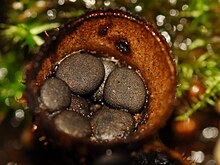
The bird's nest fungus Cyathus stercoreus
Other sexual processes
Besides regular sexual reproduction with meiosis, certain fungi, such as those in the genera Penicillium and Aspergillus, may exchange genetic material via parasexual processes, initiated by anastomosis between hyphae and plasmogamy of fungal cells.[85] The frequency and relative importance of parasexual events is unclear and may be lower than other sexual processes. It is known to play a role in intraspecific hybridization[86] and is likely required for hybridization between species, which has been associated with major events in fungal evolution.[87]Evolution
Main article: Evolution of fungi
In contrast to plants and animals, the early fossil record of the fungi is meager. Factors that likely contribute to the under-representation of fungal species among fossils include the nature of fungal fruiting bodies, which are soft, fleshy, and easily degradable tissues and the microscopic dimensions of most fungal structures, which therefore are not readily evident. Fungal fossils are difficult to distinguish from those of other microbes, and are most easily identified when they resemble extant fungi.[88] Often recovered from a permineralized plant or animal host, these samples are typically studied by making thin-section preparations that can be examined with light microscopy or transmission electron microscopy.[89] Compression fossils are studied by dissolving the surrounding matrix with acid and then using light or scanning electron microscopy to examine surface details.[90]The earliest fossils possessing features typical of fungi date to the Proterozoic eon, some 1,430 million years ago (Ma); these multicellular benthic organisms had filamentous structures with septa, and were capable of anastomosis.[91] More recent studies (2009) estimate the arrival of fungal organisms at about 760–1060 Ma on the basis of comparisons of the rate of evolution in closely related groups.[92] For much of the Paleozoic Era (542–251 Ma), the fungi appear to have been aquatic and consisted of organisms similar to the extant Chytrids in having flagellum-bearing spores.[93] The evolutionary adaptation from an aquatic to a terrestrial lifestyle necessitated a diversification of ecological strategies for obtaining nutrients, including parasitism, saprobism, and the development of mutualistic relationships such as mycorrhiza and lichenization.[94] Recent (2009) studies suggest that the ancestral ecological state of the Ascomycota was saprobism, and that independent lichenization events have occurred multiple times.[95]
The fungi probably colonized the land during the Cambrian (542–488.3 Ma), long before land plants.[96] Fossilized hyphae and spores recovered from the Ordovician of Wisconsin (460 Ma) resemble modern-day Glomerales, and existed at a time when the land flora likely consisted of only non-vascular bryophyte-like plants.[97] Prototaxites, which was probably a fungus or lichen, would have been the tallest organism of the late Silurian. Fungal fossils do not become common and uncontroversial until the early Devonian (416–359.2 Ma), when they are abundant in the Rhynie chert, mostly as Zygomycota and Chytridiomycota.[96][98][99] At about this same time, approximately 400 Ma, the Ascomycota and Basidiomycota diverged,[100] and all modern classes of fungi were present by the Late Carboniferous (Pennsylvanian, 318.1–299 Ma).[101]
Lichen-like fossils have been found in the Doushantuo Formation in southern China dating back to 635–551 Ma.[102] Lichens were a component of the early terrestrial ecosystems, and the estimated age of the oldest terrestrial lichen fossil is 400 Ma;[103] this date corresponds to the age of the oldest known sporocarp fossil, a Paleopyrenomycites species found in the Rhynie Chert.[104] The oldest fossil with microscopic features resembling modern-day basidiomycetes is Palaeoancistrus, found permineralized with a fern from the Pennsylvanian.[105] Rare in the fossil record are the homobasidiomycetes (a taxon roughly equivalent to the mushroom-producing species of the agaricomycetes). Two amber-preserved specimens provide evidence that the earliest known mushroom-forming fungi (the extinct species Archaeomarasmius legletti) appeared during the mid-Cretaceous, 90 Ma.[106][107]
Some time after the Permian-Triassic extinction event (251.4 Ma), a fungal spike (originally thought to be an extraordinary abundance of fungal spores in sediments) formed, suggesting that fungi were the dominant life form at this time, representing nearly 100% of the available fossil record for this period.[108] However, the relative proportion of fungal spores relative to spores formed by algal species is difficult to assess,[109] the spike did not appear worldwide,[110][111] and in many places it did not fall on the Permian-Triassic boundary.[112]
Taxonomy
There is no unique generally accepted system at the higher taxonomic levels and there are frequent name changes at every level, from species upwards. Efforts among researchers are now underway to establish and encourage usage of a unified and more consistent nomenclature.[39][115] Fungal species can also have multiple scientific names depending on their life cycle and mode (sexual or asexual) of reproduction. Web sites such as Index Fungorum and ITIS list current names of fungal species (with cross-references to older synonyms).
The 2007 classification of Kingdom Fungi is the result of a large-scale collaborative research effort involving dozens of mycologists and other scientists working on fungal taxonomy.[39] It recognizes seven phyla, two of which—the Ascomycota and the Basidiomycota—are contained within a branch representing subkingdom Dikarya. The below cladogram depicts the major fungal taxa and their relationship to opisthokont and unikont organisms. The lengths of the branches in this tree are not proportional to evolutionary distances.
Taxonomic groups
See also: List of fungal orders
The major phyla (sometimes called divisions) of fungi have been classified mainly on the basis of characteristics of their sexual reproductive structures. Currently, seven phyla are proposed: Microsporidia, Chytridiomycota, Blastocladiomycota, Neocallimastigomycota, Glomeromycota, Ascomycota, and Basidiomycota.[39]Phylogenetic analysis has demonstrated that the Microsporidia, unicellular parasites of animals and protists, are fairly recent and highly derived endobiotic fungi (living within the tissue of another species).[93][116] One 2006 study concludes that the Microsporidia are a sister group to the true fungi, that is, they are each other's closest evolutionary relative.[117] Hibbett and colleagues suggest that this analysis does not clash with their classification of the Fungi, and although the Microsporidia are elevated to phylum status, it is acknowledged that further analysis is required to clarify evolutionary relationships within this group.[39]
The Chytridiomycota are commonly known as chytrids. These fungi are distributed worldwide. Chytrids produce zoospores that are capable of active movement through aqueous phases with a single flagellum, leading early taxonomists to classify them as protists. Molecular phylogenies, inferred from rRNA sequences in ribosomes, suggest that the Chytrids are a basal group divergent from the other fungal phyla, consisting of four major clades with suggestive evidence for paraphyly or possibly polyphyly.[93]
The Blastocladiomycota were previously considered a taxonomic clade within the Chytridiomycota. Recent molecular data and ultrastructural characteristics, however, place the Blastocladiomycota as a sister clade to the Zygomycota, Glomeromycota, and Dikarya (Ascomycota and Basidiomycota). The blastocladiomycetes are saprotrophs, feeding on decomposing organic matter, and they are parasites of all eukaryotic groups. Unlike their close relatives, the chytrids, which mostly exhibit zygotic meiosis, the blastocladiomycetes undergo sporic meiosis.[93]
The Neocallimastigomycota were earlier placed in the phylum Chytridomycota. Members of this small phylum are anaerobic organisms, living in the digestive system of larger herbivorous mammals and possibly in other terrestrial and aquatic environments. They lack mitochondria but contain hydrogenosomes of mitochondrial origin. As the related chrytrids, neocallimastigomycetes form zoospores that are posteriorly uniflagellate or polyflagellate.[39]
Members of the Glomeromycota form arbuscular mycorrhizae, a form of symbiosis where fungal hyphae invade plant root cells and both species benefit from the resulting increased supply of nutrients. All known Glomeromycota species reproduce asexually.[70] The symbiotic association between the Glomeromycota and plants is ancient, with evidence dating to 400 million years ago.[118] Formerly part of the Zygomycota (commonly known as 'sugar' and 'pin' molds), the Glomeromycota were elevated to phylum status in 2001 and now replace the older phylum Zygomycota.[119] Fungi that were placed in the Zygomycota are now being reassigned to the Glomeromycota, or the subphyla incertae sedis Mucoromycotina, Kickxellomycotina, the Zoopagomycotina and the Entomophthoromycotina.[39] Some well-known examples of fungi formerly in the Zygomycota include black bread mold (Rhizopus stolonifer), and Pilobolus species, capable of ejecting spores several meters through the air.[120] Medically relevant genera include Mucor, Rhizomucor, and Rhizopus.

Diagram of an apothecium (the typical cup-like reproductive structure of Ascomycetes) showing sterile tissues as well as developing and mature asci.
Members of the Basidiomycota, commonly known as the club fungi or basidiomycetes, produce meiospores called basidiospores on club-like stalks called basidia. Most common mushrooms belong to this group, as well as rust and smut fungi, which are major pathogens of grains. Other important basidiomycetes include the maize pathogen Ustilago maydis,[123] human commensal species of the genus Malassezia,[124] and the opportunistic human pathogen, Cryptococcus neoformans.[125]
Fungus-like organisms
Because of similarities in morphology and lifestyle, the slime molds (myxomycetes) and water molds (oomycetes) were formerly classified in the kingdom Fungi. Unlike true fungi the cell walls of these organisms contain cellulose and lack chitin. Myxomycetes are unikonts like fungi, but are grouped in the Amoebozoa. Oomycetes are diploid bikonts, grouped in the Chromalveolate kingdom. Neither water molds nor slime molds are closely related to the true fungi, and, therefore, taxonomists no longer group them in the kingdom Fungi. Nonetheless, studies of the oomycetes and myxomycetes are still often included in mycology textbooks and primary research literature.[126]The nucleariids, currently grouped in the Choanozoa, may be a sister group to the eumycete clade, and as such could be included in an expanded fungal kingdom.[127]
Ecology
Although often inconspicuous, fungi occur in every environment on Earth and play very important roles in most ecosystems. Along with bacteria, fungi are the major decomposers in most terrestrial (and some aquatic) ecosystems, and therefore play a critical role in biogeochemical cycles[128] and in many food webs. As decomposers, they play an essential role in nutrient cycling, especially as saprotrophs and symbionts, degrading organic matter to inorganic molecules, which can then re-enter anabolic metabolic pathways in plants or other organisms.[129][130]Symbiosis
Many fungi have important symbiotic relationships with organisms from most if not all Kingdoms.[131][132][133] These interactions can be mutualistic or antagonistic in nature, or in the case of commensal fungi are of no apparent benefit or detriment to the host.[134][135][136]With plants
Mycorrhizal symbiosis between plants and fungi is one of the most well-known plant–fungus associations and is of significant importance for plant growth and persistence in many ecosystems; over 90% of all plant species engage in mycorrhizal relationships with fungi and are dependent upon this relationship for survival.[137]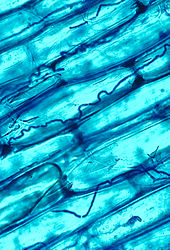
The dark filaments are hyphae of the endophytic fungus Neotyphodium coenophialum in the intercellular spaces of tall fescue leaf sheath tissue
With algae and cyanobacteria
Lichens are formed by a symbiotic relationship between algae or cyanobacteria (referred to in lichen terminology as "photobionts") and fungi (mostly various species of ascomycetes and a few basidiomycetes), in which individual photobiont cells are embedded in a tissue formed by the fungus.[143] Lichens occur in every ecosystem on all continents, play a key role in soil formation and the initiation of biological succession,[144] and are the dominating life forms in extreme environments, including polar, alpine, and semiarid desert regions.[145] They are able to grow on inhospitable surfaces, including bare soil, rocks, tree bark, wood, shells, barnacles and leaves.[146] As in mycorrhizas, the photobiont provides sugars and other carbohydrates via photosynthesis, while the fungus provides minerals and water. The functions of both symbiotic organisms are so closely intertwined that they function almost as a single organism; in most cases the resulting organism differs greatly from the individual components. Lichenization is a common mode of nutrition; around 20% of fungi—between 17,500 and 20,000 described species—are lichenized.[147] Characteristics common to most lichens include obtaining organic carbon by photosynthesis, slow growth, small size, long life, long-lasting (seasonal) vegetative reproductive structures, mineral nutrition obtained largely from airborne sources, and greater tolerance of desiccation than most other photosynthetic organisms in the same habitat.[148]With insects
Many insects also engage in mutualistic relationships with fungi. Several groups of ants cultivate fungi in the order Agaricales as their primary food source, while ambrosia beetles cultivate various species of fungi in the bark of trees that they infest.[149] Similarly, females of several wood wasp species (genus Sirex) inject their eggs together with spores of the wood-rotting fungus Amylostereum areolatum into the sapwood of pine trees; the growth of the fungus provides ideal nutritional conditions for the development of the wasp larvae.[150] Termites on the African savannah are also known to cultivate fungi,[151] and yeasts of the genera Candida and Lachancea inhabit the gut of a wide range of insects, including neuropterans, beetles, and cockroaches; it is not known whether these fungi benefit their hosts.[152]As pathogens and parasites
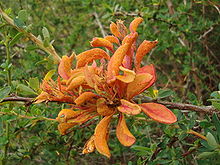
The plant pathogen Aecidium magellanicum causes calafate rust, seen here on a Berberis shrub in Chile.
Some fungi can cause serious diseases in humans, several of which may be fatal if untreated. These include aspergilloses, candidoses, coccidioidomycosis, cryptococcosis, histoplasmosis, mycetomas, and paracoccidioidomycosis. Furthermore, persons with immuno-deficiencies are particularly susceptible to disease by genera such as Aspergillus, Candida, Cryptoccocus,[136][157][158] Histoplasma,[159] and Pneumocystis.[160] Other fungi can attack eyes, nails, hair, and especially skin, the so-called dermatophytic and keratinophilic fungi, and cause local infections such as ringworm and athlete’s foot.[161] Fungal spores are also a cause of allergies, and fungi from different taxonomic groups can evoke allergic reactions.[162]
Human use
The human use of fungi for food preparation or preservation and other purposes is extensive and has a long history. Mushroom farming and mushroom gathering are large industries in many countries. The study of the historical uses and sociological impact of fungi is known as ethnomycology. Because of the capacity of this group to produce an enormous range of natural products with antimicrobial or other biological activities, many species have long been used or are being developed for industrial production of antibiotics, vitamins, and anti-cancer and cholesterol-lowering drugs. More recently, methods have been developed for genetic engineering of fungi,[163] enabling metabolic engineering of fungal species. For example, genetic modification of yeast species[164]—which are easy to grow at fast rates in large fermentation vessels—has opened up ways of pharmaceutical production that are potentially more efficient than production by the original source organisms.[165]Drugs
Many species produce metabolites that are major sources of pharmacologically active drugs. Particularly important are the antibiotics, including the penicillins, a structurally related group of β-lactam antibiotics that are synthesized from small peptides. Although naturally occurring penicillins such as penicillin G (produced by Penicillium chrysogenum) have a relatively narrow spectrum of biological activity, a wide range of other penicillins can be produced by chemical modification of the natural penicillins. Modern penicillins are semisynthetic compounds, obtained initially from fermentation cultures, but then structurally altered for specific desirable properties.[166] Other antibiotics produced by fungi include: ciclosporin, commonly used as an immunosuppressant during transplant surgery; and fusidic acid, used to help control infection from methicillin-resistant Staphylococcus aureus bacteria.[167] Widespread use of these antibiotics for the treatment of bacterial diseases, such as tuberculosis, syphilis, leprosy, and many others began in the early 20th century and continues to play a major part in anti-bacterial chemotherapy. In nature, antibiotics of fungal or bacterial origin appear to play a dual role: at high concentrations they act as chemical defense against competition with other microorganisms in species-rich environments, such as the rhizosphere, and at low concentrations as quorum-sensing molecules for intra- or interspecies signaling.[168]Other drugs produced by fungi include griseofulvin isolated from Penicillium griseofulvum, used to treat fungal infections,[169] and statins (HMG-CoA reductase inhibitors), used to inhibit cholesterol synthesis. Examples of statins found in fungi include mevastatin from Penicillium citrinum and lovastatin from Aspergillus terreus and the oyster mushroom.[170]
Cultured foods
Baker's yeast or Saccharomyces cerevisiae, a single-celled fungus, is used to make bread and other wheat-based products, such as pizza dough and dumplings.[171] Yeast species of the genus Saccharomyces are also used to produce alcoholic beverages through fermentation.[172] Shoyu koji mold (Aspergillus oryzae) is an essential ingredient in brewing Shoyu (soy sauce) and sake, and the preparation of miso,[173] while Rhizopus species are used for making tempeh.[174] Several of these fungi are domesticated species that were bred or selected according to their capacity to ferment food without producing harmful mycotoxins (see below), which are produced by very closely related Aspergilli.[175] Quorn, a meat substitute, is made from Fusarium venenatum.[176]Medicinal use
See also: Medicinal mushrooms
 |  | |
| The medicinal fungi Ganoderma lucidum (left) and Cordyceps sinensis (right). | ||
Edible and poisonous species
Edible mushrooms are well-known examples of fungi. Many are commercially raised, but others must be harvested from the wild. Agaricus bisporus, sold as button mushrooms when small or Portobello mushrooms when larger, is a commonly eaten species, used in salads, soups, and many other dishes. Many Asian fungi are commercially grown and have increased in popularity in the West. They are often available fresh in grocery stores and markets, including straw mushrooms (Volvariella volvacea), oyster mushrooms (Pleurotus ostreatus), shiitakes (Lentinula edodes), and enokitake (Flammulina spp.).[187]There are many more mushroom species that are harvested from the wild for personal consumption or commercial sale. Milk mushrooms, morels, chanterelles, truffles, black trumpets, and porcini mushrooms (Boletus edulis) (also known as king boletes) demand a high price on the market. They are often used in gourmet dishes.[188]
Certain types of cheeses require inoculation of milk curds with fungal species that impart a unique flavor and texture to the cheese. Examples include the blue color in cheeses such as Stilton or Roquefort, which are made by inoculation with Penicillium roqueforti.[189] Molds used in cheese production are non-toxic and are thus safe for human consumption; however, mycotoxins (e.g., aflatoxins, roquefortine C, patulin, or others) may accumulate because of growth of other fungi during cheese ripening or storage.[190]
Many mushroom species are poisonous to humans, with toxicities ranging from slight digestive problems or allergic reactions as well as hallucinations to severe organ failures and death. Genera with mushrooms containing deadly toxins include Conocybe, Galerina, Lepiota, and most infamously, Amanita.[191] The latter genus includes the destroying angel (A. virosa) and the death cap (A. phalloides), the most common cause of deadly mushroom poisoning.[192] The false morel (Gyromitra esculenta) is occasionally considered a delicacy when cooked, yet can be highly toxic when eaten raw.[193] Tricholoma equestre was considered edible until being implicated in serious poisonings causing rhabdomyolysis.[194] Fly agaric mushrooms (Amanita muscaria) also cause occasional non-fatal poisonings, mostly as a result of ingestion for use as a recreational drug for its hallucinogenic properties. Historically, fly agaric was used by different peoples in Europe and Asia and its present usage for religious or shamanic purposes is reported from some ethnic groups such as the Koryak people of north-eastern Siberia.[195]
As it is difficult to accurately identify a safe mushroom without proper training and knowledge, it is often advised to assume that a wild mushroom is poisonous and not to consume it.[196][197]
Pest control
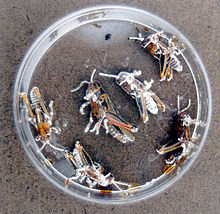
Grasshoppers killed by Beauveria bassiana
Bioremediation
See also: Mycoremediation
Certain fungi, in particular "white rot" fungi, can degrade insecticides, herbicides, pentachlorophenol, creosote, coal tars, and heavy fuels and turn them into carbon dioxide, water, and basic elements.[205] Fungi have been shown to biomineralize uranium oxides, suggesting they may have application in the bioremediation of radioactively polluted sites.[206][207][208]Model organisms
Several pivotal discoveries in biology were made by researchers using fungi as model organisms, that is, fungi that grow and sexually reproduce rapidly in the laboratory. For example, the one gene-one enzyme hypothesis was formulated by scientists who used the bread mold Neurospora crassa to test their biochemical theories.[209] Other important model fungi are Aspergillus nidulans and the yeasts, Saccaromyces cerevisiae and Schizosaccharomyces pombe, each of which has a long history of use to investigate issues in eukaryotic cell biology and genetics, such as cell cycle regulation, chromatin structure, and gene regulation. Other fungal models have more recently emerged that each address specific biological questions relevant to medicine, plant pathology, and industrial uses; examples include Candida albicans, a dimorphic, opportunistic human pathogen,[210] Magnaporthe grisea, a plant pathogen,[211] and Pichia pastoris, a yeast widely used for eukaryotic protein expression.[212]Others
Fungi are used extensively to produce industrial chemicals like citric, gluconic, lactic, and malic acids,[213] and industrial enzymes, such as lipases used in biological detergents,[214] cellulases used in making cellulosic ethanol[215] and stonewashed jeans,[216] and amylases,[217] invertases, proteases and xylanases.[218] Several species, most notably Psilocybin mushrooms (colloquially known as magic mushrooms), are ingested for their psychedelic properties, both recreationally and religiously.Mycotoxins
![(6aR,9R)-N-((2R,5S,10aS,10bS)-5-benzyl-10b-hydroxy-2-methyl-3,6-dioxooctahydro-2H-oxazolo[3,2-a] pyrrolo[2,1-c]pyrazin-2-yl)-7-methyl-4,6,6a,7,8,9-hexahydroindolo[4,3-fg] quinoline-9-carboxamide](http://upload.wikimedia.org/wikipedia/commons/thumb/9/94/Ergotamine3.png/220px-Ergotamine3.png)
Ergotamine, a major mycotoxin produced by Claviceps species, which if ingested can cause gangrene, convulsions, and hallucinations
Mycotoxins are secondary metabolites (or natural products), and research has established the existence of biochemical pathways solely for the purpose of producing mycotoxins and other natural products in fungi.[221] Mycotoxins may provide fitness benefits in terms of physiological adaptation, competition with other microbes and fungi, and protection from consumption (fungivory).[222][223]
Mycology
Mycology is the branch of biology concerned with the systematic study of fungi, including their genetic and biochemical properties, their taxonomy, and their use to humans as a source of medicine, food, and psychotropic substances consumed for religious purposes, as well as their dangers, such as poisoning or infection. The field of phytopathology, the study of plant diseases, is closely related because many plant pathogens are fungi.[224]Use of fungi by humans dates back to prehistory; Ötzi the Iceman, a well-preserved mummy of a 5,300 year old Neolithic man found frozen in the Austrian Alps, carried two species of polypore mushrooms that may have been used as tinder (Fomes fomentarius), or for medicinal purposes (Piptoporus betulinus).[225] Ancient peoples have used fungi as food sources–often unknowingly–for millennia, in the preparation of leavened bread and fermented juices. Some of the oldest written records contain references to the destruction of crops that were probably caused by pathogenic fungi.[226]

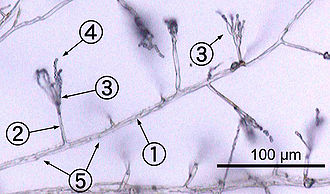
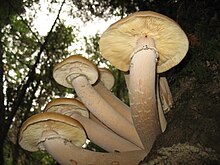

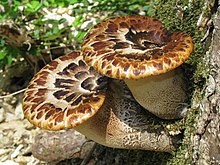


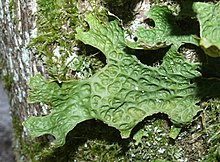

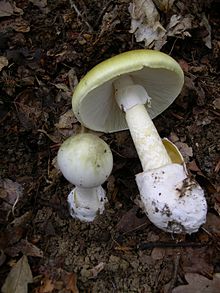

No comments:
Post a Comment